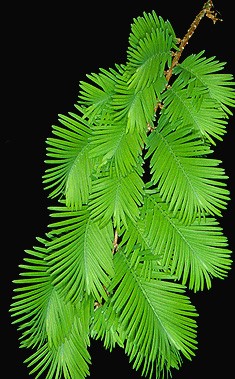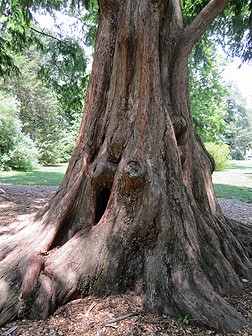Name That Tree

Leaves are described as pinnately compound
If you chose dawn redwood, you are correct! Dawn redwoods (Metasequoia glyptostroboides) are closely related to bald cypress (Taxodium) and redwood (Sequoia) trees. All three trees are of ancient lineage. Fossils of dawn redwood trees date back 50 million years! Interestingly, the dawn redwood was thought to be extinct until it was discovered growing in a forest in central China in 1941. Seeds were collected by the Arnold Arboretum, and gardeners have benefitted from its beauty ever since.
The first time I saw one was on a walk. I thought it might be a larch or tamarack because it dropped its “needles” in the fall. One time, the owner happened to be outside, and he informed me that it was a dawn redwood. I have now learned that the foliage of the dawn redwood does look like the needles of an evergreen tree, but they are in fact leaves and they are shed every fall. The fern-like leaves are flat, soft and about one-half inch long. Light-green in spring, they turn a deeper green during the summer. Their typical fall color is an orangish-brown to reddish-bronze.
 This stately, large tree grows from 70 to 100 feet tall and 20 to 25 feet wide in a clearly conical shape. Its reddish-brown bark deepens in maturity and exfoliates in thin strips. The straight trunk of old trees becomes fluted and fissured with age. A fast-growing tree, it can add two to three feet of growth a year!
This stately, large tree grows from 70 to 100 feet tall and 20 to 25 feet wide in a clearly conical shape. Its reddish-brown bark deepens in maturity and exfoliates in thin strips. The straight trunk of old trees becomes fluted and fissured with age. A fast-growing tree, it can add two to three feet of growth a year!
The dawn redwood is monoecious, which means that it has both male and female flowers on the same tree. The box-like cones are light brown and one-half to one-inch long. They hang on long stalks. The winged seeds mature in late autumn.
The dawn redwood is tolerant of a variety of growing conditions including clay, acid, sandy, loamy and wet soils. It can also withstand deer browsing and air pollution. However, it grows best in full sun and in moist to average soil in zones 4 to 8. It has no serious insects or pests. It is important when planting a dawn redwood to be sure that it has adequate room for its large size. While it does not have much wildlife benefit, it does provide cover for birds, small mammals and deer.
 Nonetheless, how exciting to grow a tree that stood when dinosaurs were roaming the earth. An imposing and majestic tree, its large size and beautiful symmetry make it an excellent “tried and trouble-free” landscape tree.
Nonetheless, how exciting to grow a tree that stood when dinosaurs were roaming the earth. An imposing and majestic tree, its large size and beautiful symmetry make it an excellent “tried and trouble-free” landscape tree.
References
• Dawn Redwood, Metasequoia glyptostroboides, VCE Publication
3010-1474
• Metasequoia glyptostroboides, Missouri Botanical Garden
• Tree of the Week: Dawn Redwood (Metasequoia glyptostroboides),
The UFore Nursery & Lab, University of Minnesota
• Dawn redwood, Virginia Tech Dendrology
• Dirr’s Encyclopedia of Trees & Shrubs, 1st edition, by Michael A. Dirr